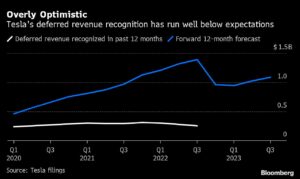Tesla Inc. is making its controversial driver-assistance system available to customers previously deemed not safe enough behind the wheel to test it out.
Chief Executive Officer Elon Musk tweeted that the system Tesla calls Full Self-Driving Beta is now available to anyone in North America who’s bought the option and requests it from their car screen. Until now, some paying customers have been blocked from accessing the feature known as FSD because they didn’t score high enough on metrics Tesla uses to set insurance rates.
FSD has been a lightning rod for criticism because the product hasn’t lived up to Musk’s statements. He first announced his plan to sell it in October 2016, a few months after he told a tech conference that he considered autonomous driving to be “basically a solved problem.” In 2019, he said that within roughly a year, Tesla’s technology would advance to the point that no human would need to be behind the wheel.
Those predictions haven’t panned out: FSD still requires a fully attentive driver to keep their hands on the wheel and be ready to take over at any moment. This disconnect has opened Tesla up to intensifying legal and regulatory risk:
- The US Justice Department and Securities and Exchange Commission have been investigating Tesla’s self-driving claims, a person familiar with the matter said last month.
- A customer in California is seeking class action status for his lawsuit filed in September claiming that Tesla has deceptively marketed its driver-assistance systems.
- California’s Department of Motor Vehicles accused the company in August of misleading consumers about its FSD and Autopilot systems.
It’s unclear whether making FSD available to more customers will have any bearing on Tesla generating or recognizing more revenue just after Musk acknowledged demand for its vehicles has been “a little harder” to come by. The company has said it only recognized a portion of the amounts customers pay for FSD, with the remainder going to a deferred revenue balance.
“FSD purchases haven’t been fully recognized in Tesla’s P&L because consumers had bought a promise rather than a fully working product,” Patrick Hummel, a UBS analyst with a buy rating on the stock, said in a Nov. 14 note.
At the end of September, Tesla’s deferred revenue balance was at $2.8 billion. While the company said then that it expected to recognize $1.09 billion of deferred revenue in the coming 12 months, Tesla has for years overestimated this figure.
Musk has taken advantage of a relatively light-touch approach to regulating automated-driving technology in the US. The National Highway Traffic Safety Administration said shortly before Tesla’s first fatal crash involving Autopilot in 2016 that existing laws in the country posed few barriers to driver-assistance systems.
When asked in March when Europeans will get to test FSD, Musk told fans at the plant Tesla was opening near Berlin that the company was holding off because regulators in the region were less permissive.
“In the US, things are legal by default,” Musk said. “In Europe, they’re illegal by default. So we have to get approval beforehand, whereas in the US, you can kind of do it on your own cognizance, more or less.”
The National Highway Transportation Safety Board, which lacks the power to compel carmakers to follow its recommendations, has been critical of Tesla’s deployment of Autopilot and FSD.
“We essentially have the Wild West on our roads right now,” NTSB Chair Jennifer Homendy told Bloomberg earlier this year. “It is a disaster waiting to happen.”
Was this article valuable?
Here are more articles you may enjoy.


 NYC Sues Delivery App Over Lost Pay in New Mamdani Crackdown
NYC Sues Delivery App Over Lost Pay in New Mamdani Crackdown  Munich Re: Insured Losses From Wildfires, Storms and Floods Hit Record High
Munich Re: Insured Losses From Wildfires, Storms and Floods Hit Record High  First Brands Judge Approves Examiner to Probe Fraud Allegations
First Brands Judge Approves Examiner to Probe Fraud Allegations  Storm Goretti Batters Europe With Violent Winds, Power Cuts
Storm Goretti Batters Europe With Violent Winds, Power Cuts 